A blog about how-to, internet, social-networks, windows, linux, blogging, tips and tricks.
22 August 2018
Google’s G Suite apps and Calendar are getting Gmail’s side panels
One of the best features of the new Gmail is its quick-access side panel with easy access to Google Calendar, Tasks, Keep and your Gmail extensions. Now, Google is bringing this same functionality to Google Calendar, Docs, Sheets, Slides and Drawings, too.
In Google Calendar, you’ll be able to quickly access Keep and Tasks, while in the rest of the G Suite apps, you’ll get easy access to Calendar, Keep and Tasks.
In Gmail, the side panel also brings up access to various G Suite extensions that you may have installed from the marketplace. It doesn’t look like that’s possible in Docs and Calendar right now, though it’s probably only a matter of time before there will be compatible extensions for those products, too. By then, we’ll likely see a ‘works with Google Calendar’ section and support for other G Suite apps in the marketplace, too.
I’m already seeing this in my personal Google Calendar, but not in Google Docs, so this looks to be a slow rollout. The official word is that paying G Suite subscribers on the rapid release schedule should get access now, with those on the slower release schedule getting access in two weeks.

Read Full Article
Lyft hires Google veteran to build out business platforms
Lyft has hired Google veteran Manish Gupta as vice president of engineering to build out the ride-hailing company’s business platforms, including enterprise, partnerships, and healthcare.
Gupta will report directly to Peter Morelli. He will work alongside Ran Makavy, who heads up Lyft’s ride-share technology team, CFO Chris Lambert, and Katie Dill, the company’s vice president of design.
In this newly created position, Gupta will also oversee Lyft employees working on payments, fraud prevention, and privacy.
Gupta’s hiring comes amid explosive growth at the ride-hailing company. Two years ago, Lyft’s ride-hailing app was accessible in less than 50% of the U.S. and had only 17% market share—far behind rival Uber.
Today, Lyft has 96% coverage in the U.S. and 35% market share. The company’s driver network has grown from 315,000 in 2015 to 1.4 million drivers in 2017. It’s employee ranks have grow more than fivefold to 3,600 people.
The ride-hailing company’s bookings run rate based on a second quarter estimate is $7.7 billion.
Lyft Business, the company’s enterprise unit, has also expanded in the past two years as it partners with more organizations and companies like Starbucks, LAX, Allstate, Hewlett Packard Enterprise, JetBlue, Delta, and Blue Cross Blue Shield.
The company is increasingly focused on the potential of these business partnerships, particularly with healthcare organizations and non-emergency medical transport. For example, a hospital or doctor’s office, could use a desktop version of the Lyft app to order a ride for a patient. Lyft already has partnerships with some of the largest health systems in the U.S., including Ascension, Denver Health System, Hennepin County Medical Center and El Camino Hospital.
It’s in here where Lyft hopes to tap into Gupta’s experience.
Gupta has been at Google since 2002 in a variety of roles, most recently leading its Google Ads’ buy-side platform. During Manish’s 16-year tenure at Google, he also built AdSense for TV, Video and Display ads, and the billing and payments system for advertisers and publishers.
Read Full Article
Airbnb vs. VRBO vs. Homeaway vs. Hotel: Which Is Better for You?

When you’re traveling to a new city, your choices today aren’t limited to hotels alone. Sites like Airbnb, Homeaway, and VRBO let homeowners rent their spaces to travelers. Which one is right for you though?
Airbnb is now the biggest of these sites to find a place to stay. But HomeAway and VRBO, both part of the Expedia network, aren’t too far behind. Each has its own pros and cons, but the one thing they have in common are the security threats you need to know.
What Sets Airbnb Apart
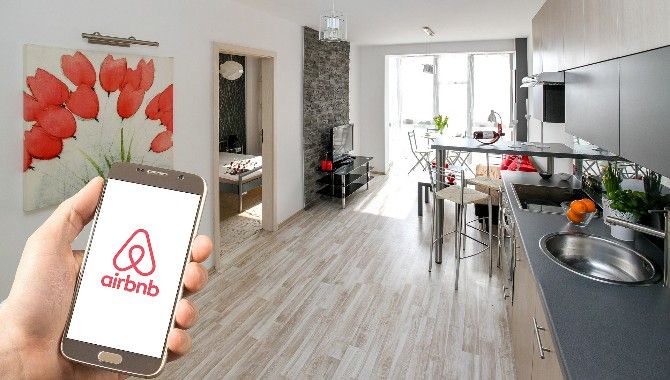
Generally speaking, an Airbnb listing will be cheaper than hotels and serviced apartments. It’s perfect for backpackers. But booking a room on Airbnb over a hotel gives you several benefits that you probably didn’t think about.
- You will meet, stay, and hang out with locals. Get a well-rated host and you’ll find someone happy to show you around the city, give you great ideas, and generally make your stay awesome.
- Your costs are flexible. Go grocery shopping with your host and cook up a dinner at home. You might end up saving some money.
- The small comforts of a home will add up to awesomeness. Hotels will charge for every small amenity or service. On the other hand, your Airbnb host usually won’t mind you borrowing everyday household items.
Airbnb vs. HomeAway
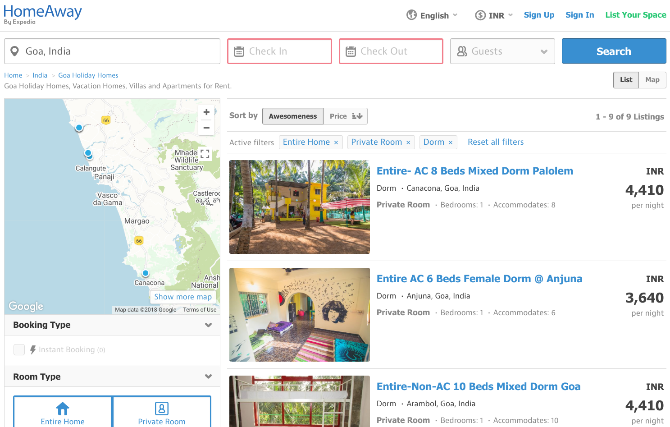
HomeAway and Airbnb operate in the same number of countries. HomeAway has roughly two million listings, compared to Airbnb’s four million. Based on pure numbers, HomeAway is Airbnb’s largest competitor.
Biggest Differences Between Airbnb and HomeAway
- HomeAway has better reviews. While both sites only let actual renters post a review after successfully checking out, for some reason, Airbnb has a 14-day time limit. HomeAway lets renters write reviews up to a year from the time of booking. As a result, you tend to get more reviews, and better reviews, on HomeAway.
- Don’t let the service fee matter. Yes, HomeAway’s guest fee is 6-12%, while AirBnB’s service fee is 0-20%. But while the percentages vary, the average fee comes to the same for similar listings.
- HomeAway offers insurance against last-minute cancellation. Imagine landing in a new place and finding out your host has canceled your reservation. It’s a common problem on Airbnb, and the company makes you fend for yourself. Sure, you’ll get a refund, but a last-minute booking is going to cost a lot. On the other hand, HomeAway offers insurance with its Book With Confidence Guarantee. This includes not just a refund, but rebooking assistance in case of last-minute cancellations, so your costs don’t go up.
When to Use HomeAway Over Airbnb
I don’t think it’s a case of using one over the other. When you’re researching your travel plans, check the listings on both Airbnb and HomeAway. The listings don’t always overlap, and there isn’t a universal search aggregator.
Airbnb vs. VRBO
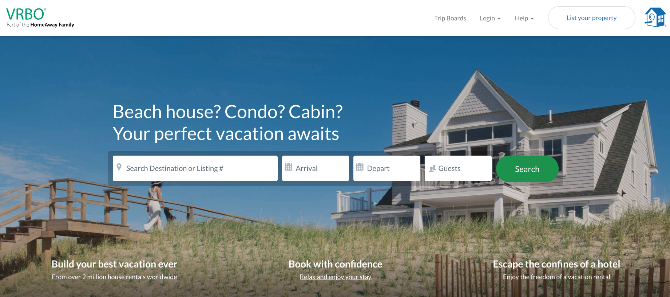
VRBO (Vacation Rental By Owner) looks and feels like a much more expensive site than Airbnb. What makes it one of the high quality alternatives to Airbnb is that VRBO caters to a slightly more upmarket crowd.
Biggest Differences Between Airbnb and VRBO
- VRBO lets you rent only full houses, not a single or shared room. In a way, this is good because you know there are no hidden clauses about someone else sharing the space. It’s a persistent problem on Airbnb, with many travelers complaining about false advertising.
- VRBO’s service fee is 6-12%, while Airbnb’s service fee is 0-20%. That said, Airbnb service fees reduce as the total rental cost increases. VRBO homes are generally more expensive than those listed on Airbnb, so the fee looks hefty for long stays.
- VRBO cancellation policies are a little different from Airbnb. While both give you full or partial refunds, I found VRBO’s listings generally require you to cancel a month or more in advance for any sort of refund. Airbnb almost always gives you free cancellation in the next 48 hours from the time of your booking.
When to Use VRBO Over Airbnb
When you’re not on a budget and instead booking a vacation home for a family or a get-together, VRBO will be the better choice. The kinds of homes listed here are not available on Airbnb, which is a more mass-market site in some ways. VRBO’s listings look premium, and usually have price tags to match. But hey, you pay more for quality.
Airbnb vs. Hotels

While we’ve talked about the benefits of Airbnb over hotels, it’s not for everyone. Hotels are a service industry, while Airbnb listings are about fending for yourself.
Biggest Differences Between Airbnb and Hotels
- The conveniences of a hotel are tremendous. You’ll get 24-hour check-in, enter and leave the room at your own timings, get room service, and a maid will clean up your room while you’re away. That’s not an experience you can expect on Airbnb. If you want a vacation where you get what you want and when you want it, a hotel will always be better.
- Hotels offer last-minute deals, which Airbnb doesn’t. Again, since hotels are a business, they will often slash their prices at the last minute because their job is to fill up rooms. Airbnb hosts work on tighter margins, so they aren’t likely to do last-minute deals.
- Earn and redeem loyalty points. Hotel chains across the world give you loyalty points, usually on the same cards as your frequent flyer miles and other travel purchases. Plus, once you master the tips and tricks of Booking.com, you will get hotel rooms at prices that even Airbnb can’t match sometimes.
When to Use Hotels Over Airbnb
Do you want independence or do you want convenience? Anyone who wants independence while traveling should go with an Airbnb. Anyone who wants the convenience of a vacation should go with a hotel.
Looking for the Cheapest Stay?
For budget travelers, it doesn’t matter which service you use. It’s all about finding the best deal for a low price. There are sites like Tripping that let you search across every vacation rental listing apart from Airbnb.
Depending on what you want, start your search using these sites for finding free or cheap accommodation.
Image Credit: Syda_Productions/Depositphotos
Read the full article: Airbnb vs. VRBO vs. Homeaway vs. Hotel: Which Is Better for You?
Read Full Article
This is the Google Pixel 3 XL
It’s most likely not going to be out until October, but we’ve already seen a lot of Google’s Pixel 3. A lot, a lot. And here’s a lot more.
The umpteenth leak of the upcoming smartphone details just about every nook and cranny you could even want to see of the thing. In fact, there are actually competing leaks of the device this morning , one of which actually took the handset’s camera for a spin, publishing a number of those photos.
It’s tough to say how much of this is controlled leaking is intentional. Ultimately, these leaks keep the product on the radar well ahead of launch, even if they do remove most or all of the surprise. Whatever the case, this thing is all over the place.
In the case of the Pixel 3/Pixel 3 XL, reaction seems to be reasonably positive to everything but that massive notch up top. Of course, Google’s really leaning in on the notch front, having added that functionality with the recent release of Android Pie.

The new photos comport with just about everything we’ve see so far, including the single camera on the rear and the inclusion of what appears to be a wired version of the Pixelbuds, which require the included USB-C dongle/adapter.
There’s a reported 2960 × 1440 pixel display on the 3 XL, beating out the 2 XL’s 2880×1440. That’s due in part to the fact that the new phone has a downright massive 6.7-inch display, per rumors. That towers over even the Note 9’s 6.4 inches.
By all accounts there’s a Snapdragon 845 here, which certainly makes sense. And, of course, the handset will be running Android Pie.
Oh yeah, and then there’s this.
Read Full Article
The 6 Best Linux Distros to Install on a Mac (Depending on Your Needs)

Believe it or not, Apple hardware is popular with many Linux users. Even longterm Mac users sometimes feel like a change, and while Windows 10 is an option, Linux can also freshen up your workstation.
But with so many different versions of Linux available, it can be difficult to know where to start. The answer will depend on your level of skill, what you value from an OS, and what you’re going to be using your computer for.
So here are some different distributions for the Linux-curious Mac user.
1. Ubuntu
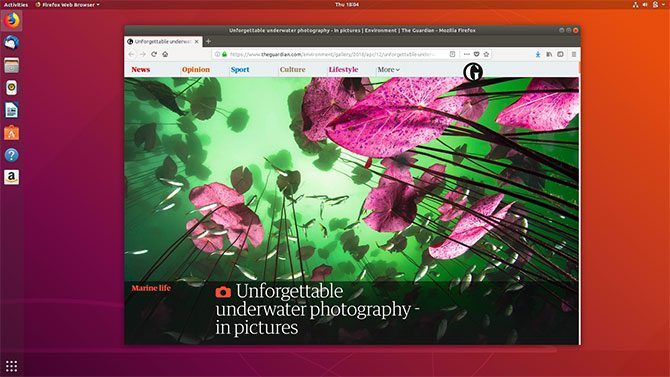
You might call it boring, but Ubuntu is easily the most accessible flavor of Linux out there. The other reason I’m recommending it above all else is that it’s one of the most well-supported versions of Linux in terms of driver support.
For Apple users, that means all of their hardware (including the frequently problematic wireless adapter) should work right out of the box. There’s no need to dig out an Ethernet adapter and hunt across the web for a Wi-Fi driver that works.
Ubuntu is also well-catered for in terms of software support, with a rich repository of software built right into the base install. The OS feels like it was built with the intent of breaking down many of the barriers that make the OS prohibitive to many, and just like macOS there’s a ton of great software included to get you started.
Also consider Ubuntu GNOME if you like the look of the GNOME desktop environmental and aren’t too fussed about the latest and greatest release. The official GNOME release of Ubuntu is currently around a year out of date, but it looks and feels more like the macOS interface Mac owners are used to.
Download: Ubuntu
2. elementary OS
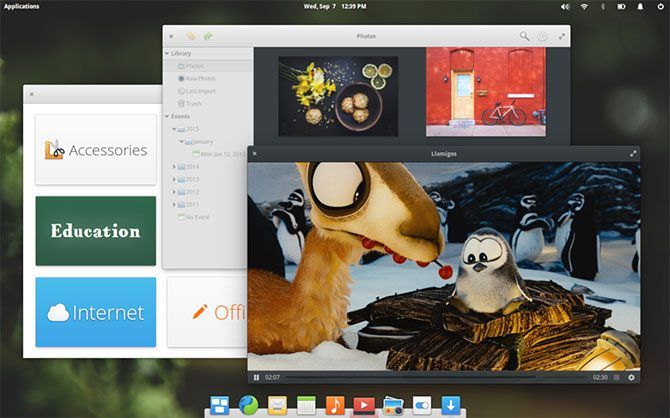
If you’re considering trying out Linux on your MacBook and value desktop aesthetics above all else, elementary OS might be just the ticket. macOS users will immediately feel right at home since the desktop environment shares a lot in common with Apple’s own operating system.
At the bottom of the screen you’ll find a dock, not dissimilar to the one found in macOS. At the top of the screen is elementary’s menu bar, and there’s a Spotlight-like search interface for launching apps, accessing settings, and running commands from a text prompt.
AppCenter is the elementary OS equivalent of the Mac App Store (though many other distributions feature a similar system), with built in support for pay-what-you-want software contributions to support developers. The team behind the OS even encourage a contribution upon downloading.
Even the system icons have that bright, colorful Apple glow. Software support is also great, with anything built for Ubuntu 16.04 LTS capable of working with elementary OS 0.4 “Loki.” Retina display support is good, though your wireless adapter and MacBook webcam may require a bit of driver hunting.
Download: elementary OS
3. Manjaro
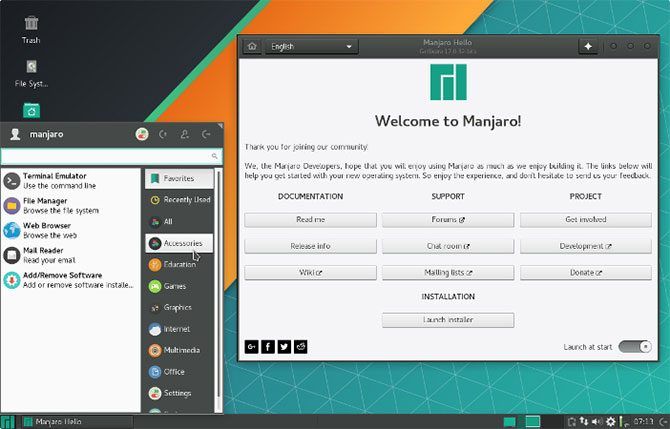
Arch Linux is known among Linux enthusiasts for its speed and performance, but its primary audience are the more experienced users out there. Based on Arch, Manjaro attempts to provide the many benefits that have earned Arch its reputation in a user-friendly package.
It does this by building upon the powerful Arch Linux core, with access to the Arch User Repository, and the same rolling release development model. But Majaro holds your hand as much as possible, including a vastly simplified installation process and pre-installed codecs for easy playback of media.
Among the standout features is the ability to detect your computer’s hardware, with automatic installation (where supported) of software and drivers for your particular system. This is particularly useful to Mac users, where support for drivers can be hard to come by. There’s also access to Manjaro-specific software repositories to ensure that software is stable and tested before you install it.
There are four official flavors of Manjaro using three separate desktop environments: Xfce (for older machines), KDE, GNOME, and an architect version for custom setups. You can also download Community Editions, including one that uses Chrome-like window manager Budgie. There’s a thriving user support forum in case you get stuck, and the emphasis on user friendliness is truly refreshing.
Download: Manjaro
4. Lubuntu
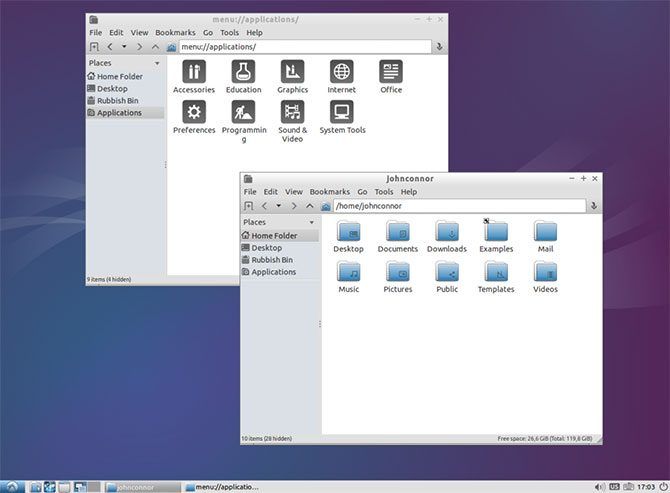
Got a crusty old MacBook? Maybe Apple has discontinued support for your machine, and you’re not too thrilled about it. Is your Mac even crustier than that? Those of you still rocking PowerPC hardware can inject new life with the right distribution.
Lubuntu is a solid choice. It’s an unashamedly lightweight version of Ubuntu that uses the minimal LXDE desktop environment. In place of the usual Ubuntu fare are a suit of similarly lightweight applications with very low hardware requirements.
On top of this, it’s frequently updated with 32-bit and 64-bit version available for most PCs built in the last 15 years. There are also PowerPC LTS (longterm support) builds for older Mac models, and a Raspberry Pi optimized version too.
If you want to turn your ageing old Mac into something useful like a word processor, file server, or simple web browser for office use, give Lubuntu a whirl. Compatibility with Ubuntu software and hardware optimizations make it a great choice for newbies too.
If you’re rocking an old PowerPC Mac and are looking for something else, check out the Linux on PowerPC Mac Facebook group.
Download: Lubuntu
5. Ubuntu Studio

If you’re using your Mac primarily for creative endeavours, it makes sense to opt for a creative Linux distribution. Ubuntu Studio is focused on creating art, whether it’s music and audio, graphic design and photography, videography, or publishing. Yes, it’s another flavor of Ubuntu, but one that includes a ton of tools to get you started quickly.
While you could track down and install all of these tools on virtually any version of Linux, Ubuntu Studio includes them out of the box. For audio work there’s the excellent Audacity for simple audio editing, the extensive digital audio workstation Ardour, and low latency audio routing and MIDI solution JACK ready to rock out of the box.
If you’re a visual artist you can get going right away with powerful 3D modelling tool Blender, vector graphics workhorse Inkscape, Photoshop alternative GIMP, and graphics tablet-ready painting tool MyPaint. Photographers can edit their RAW images using Darktable, then manage them in a Shotwell library.
Simple video editor Openshot is also included, alongside video powerhouse FFMPEG for converting, decoding, encoding, muxing, and playing virtually every video format under the sun. The whole thing is backed up with LibreOffice 3, PDF creation tool Scribus, and open source eBook app Calibre.
As with other Ubuntu releases, it’s compatible with Ubuntu’s unbeatable repository of software. If you’re looking for something similar but don’t fancy Ubuntu, check our Fedora’s Design Suite.
Download: Ubuntu Studio
6. AVLinux

AVLinux is aimed at multimedia content producers looking to edit video or create music on their Linux systems. Unlike Ubuntu Studio, AVLinux is based on Debian and ships with a customized kernel designed with low latency audio production in mind.
The idea is to squeeze as much performance out of your computer as possible, which is why developers opted for a modified lightweight Xfce desktop environment. This is one distribution that sacrifices everything in the name of reducing the strain placed on your computer from simply running the OS.
As a result, it’s super barebones though it does come with a smattering of audiovisual tools. These include Ardour for creating music, Audacity for simple audio editing, Guitarix for guitar amplifier simulation, and open source drum machine Hydrogen. You’ll also find video tools like Blender, Cinellerra, Kdenlive and Openshot installed, along with LibreOffice, Firefox and GIMP.
Interestingly, legendary audio console manufacturer Harrison of Nashville, Tennessee recommends AVLinux for use with their Mixbus digital audio workstation. Expect to be hunting for drivers (depending on your hardware) if you’re opting for AVLinux.
Download: AVLinux
How to Boot Linux on Your Mac
Installing Linux on your Mac is a lot easier than it once was, since you no longer have to open up Terminal and create your installation medium using command line prompts. Simply download the USB image of your choice, grab a spare USB drive (make sure there’s nothing on it you want to keep) and download Etcher.
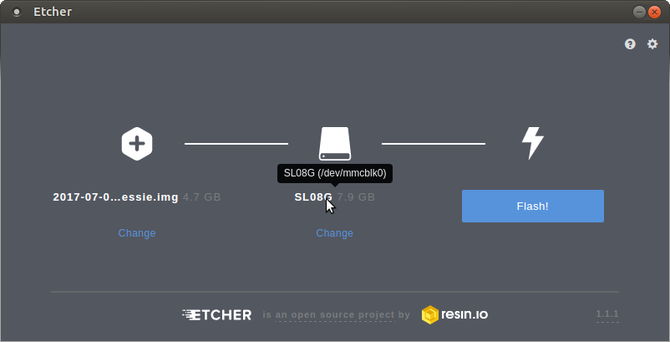
This wonderful piece of open source software allows you to create a bootable USB drive with your choice of Linux distribution on it in around three clicks. Select your Linux image, choose the appropriate thumb drive, and click Flash! to get started.
Now reboot your Mac and hold the Option key while it starts. Choose the USB drive you created from the list (avoiding Macintosh HD) and wait for your chosen OS to boot. Most live distributions include installation wizards either in the bootloader or the OS itself to install Linux permanently.
These Linux distributions aren’t the only alternative operating systems for your Mac. If your Mac has enough power, you could run some of them just fine under VirtualBox on top of your existing macOS setup if you want!
Read the full article: The 6 Best Linux Distros to Install on a Mac (Depending on Your Needs)
Read Full Article
8 Airbnb Nightmares and the Lessons You Can Learn From Them

Airbnb is a very popular vacationing alternative for many travelers around the world. It’s also a very lucrative way for homeowners to monetize their property whenever it’s vacant. But there are horror stories too.
The majority of Airbnb rentals go very smoothly.
Travelers get access to a place to stay that’s roughly equal to or less than the price of a hotel room but offer a uniquely different experience than staying in a hotel. Many Airbnb rentals let you experience a vacation area from a uniquely “local” perspective. Many Airbnb hosts will even provide their guests with recommendations for the best local restaurants or sights to visit.
Unfortunately, there is always a risk that what should be a friendly exchange of money for lodging could turn into a complete nightmare for either the Airbnb host or their guests. The following are a few real examples of actual Airbnb disasters that happened to hosts and guests.
1. When Guests Refuse to Leave
One woman in California found out the hard way that rental laws also apply to Airbnb rentals as well.
In a surreal situation, Airbnb guests who had rented her home actually refused to leave. And under California law, landlords need to give renters a thirty-day notice before they can be evicted. This meant that the guests were able to stay in the home during that time.
Security cameras showed the guests going through the woman’s refrigerator and cupboards, and rummaging through her belongings. In the end, the woman paid the guests $1700 just to get them to finally leave.
2. Temporary Pop-Up Brothels
Imagine if you owned a home and decided to make a little bit of money to rent a spare room in your home through Airbnb. What if you discovered that the people renting that room were actually using it to run a brothel?
That’s exactly what happened to one man who rented out his New York City apartment on Airbnb. The man who rented it told him that his brother and sister-in-law were visiting. As he later found out, the guest had actually used the apartment for what the host described as a “large orgy”.
NYC authorities told media sources that a number of Airbnb guests actually turn out to be prostitutes who are looking for temporary locations to run their businesses out of. By changing location often, they’re able to evade authorities more easily. The homeowners who are renting out their property have no idea that illegal activity is going on there.
3. Massive Parties and Damage
One man in Ohio listed his home available for rent on Airbnb. In one case, the parents who had rented the home left their kids there alone while they went to a football game. The kids ransacked the house and caused serious damage to the property.
Only two weeks after that, another renter held a massive party at the house, inviting more than thirty guests without permission. The man explained that there were, “bottles and cans everywhere—floors were sticky; there was stuff on the walls…it was horrible.”
The end result was that the man failed to obtain compensation from Airbnb because, as he explained, the company required “ridiculous documentation”.
4. Drugs and Parties
One couple in Calgary found out the hard way what can happen when you don’t properly vet your Airbnb guests. After a single weekend away from their home, they returned to a complete disaster.
The couple had rented their house to a man who claimed he and three guests were there to attend a wedding. But as it turned out, according to neighbors, busloads of over 100 partiers filled the house. The damage was every Airbnb host’s worst nightmare. Police later described the situation as a “drug-induced orgy.”
The furniture was destroyed. Garbage, cigarette butts, and broken glass littered the house. Most disturbing, there were body fluids discovered all throughout the house as well. According to the couple, the repairs to the house were valued at approximately $52,000 to $77,000.
5. Renting a Drug House
The last thing you might expect while on your family vacation is ending up in the middle of a police raid. That’s exactly what happened to one family from Sydney, Australia, during their family vacation to the Gold Coast.
It was only the very first day of their vacation when police suddenly barged in and arrested the family for questioning. As it turns out, the home they had rented was actually a marijuana grow house.
They were able to enjoy the rest of their vacation staying in a hotel room, but spending a day in police questioning isn’t exactly a great way to start a family vacation.
6. You Could Face Racial Profiling
In Canada, Bob Marley’s granddaughter and her friends had rented an Airbnb house in Rialto, California, in a predominantly white neighborhood. Not long after arriving at the property, police showed up knocking at the door.
As it turned out, a neighbor had seen the trio bringing luggage into the house. The neighbor told reporters, “I see these strange people coming and going back and forth, you know, with luggage. And I didn’t recognize them.”
However, the granddaughter and her friends believe the police had only been called because of racial profiling.
If you think this is just a rare example of racism in the Airbnb marketplace, you might be surprised.
In fact, one woman named Dyne Suh had driven through a snowstorm to get to her rental in Big Bear, California.
On her way there, the host canceled the reservation via the text message. According to Dyne, the host had texted her:
“I would’t rent to u if u were the last person on earth. One word says it all. Asian.”
It’s one of those surreal situations that you probably wouldn’t believe actually could happen in modern until it happens to you.
7. You Could Get Kicked Out of an Illegal Rental
Many communities around the country are banning short-term rentals like Airbnb. And even in communities where they are allowed, a number of rental properties have specific policies against subletting apartments.
This is what happened to European tourists who had rented an Airbnb apartment in New York City. Not only was the condition of the rental sub-par, but as it turned out the apartment was government-subsidized and subletting was not allowed.
If you consider that New York City law bans short-term rentals, that means most Airbnb rentals there are illegal.
According to New York State Attorney General Eric Schneiderman:
“72 percent of units used as private short-term rentals on Airbnb appeared to violate these laws.”
If you are one of the people renting one of these illegal rentals, nothing may happen at all. With tens of thousands of listings in New York City alone, it’s clear that the laws aren’t being aggressively enforced.
But ending up as one of the exceptions wouldn’t make for a very good vacation. At the very least, you could end up confronted by angry neighbors who don’t like the fact that their neighbors are letting strangers come into these apartment buildings.
8. Interruptions Throughout Your Entire Stay
In one of the most surreal situations, YouTube vloggers rented an Airbnb home in Mexico for five months. When they arrived, they discovered a “For Sale” sign on the front lawn.
All during their stay, they had potential buyers or real estate agents constantly interrupting them during their stay. Realtors actually asked them nearly every day to leave the house during certain times of the day (and to clean it up!) so that they could do a house showing. Once the house sold a week into their stay, they were asked to move out within thirty days.
The problem with Airbnb rentals like this is that there aren’t strictly enforced contracts, so the hosts only need to comply with local rental laws when they decide to kick you out of the rental.
Airbnb Is Useful, If You Play it Smart
The reality is that the Airbnb market opened up because people want to be able to travel affordably. Hotel prices continue to rise, making travel something that only the wealthy can enjoy.
When homeowners are willing to open up their homes to travelers, and when travelers are willing to treat those homes respectfully, it can open up a whole new world of adventure for people who normally couldn’t have afforded it. You just need to be aware of some of the security risks involved in Airbnb rentals.
There are a few things you can do to protect yourself as a host of an Airbnb rental.
- Ask enough questions. Determine why the guest is traveling to your area and what their plans are.
- Be selective. Only accept guests who’ve provided Airbnb with their passport or driver’s license for identity purposes.
- Specify house rules clearly. Make sure you lay out the “house rules” in writing upon guest arrival, and ask trusted neighbors to inform you if anything seems out of the ordinary.
- Trust your gut. If something seems “off”, then trust your gut and simply refuse the guest. Better to play it safe then end up with a destroyed property.
In general, the same rules apply if you’re a guest.
- Do your homework about the host who’s renting out their property.
- Verify that Airbnb rentals are legal in the area you’re looking to rent.
- If the rental is in an apartment building, confirm with the building owner that the Airbnb is allowed.
While doing your homework won’t prevent all unexpected surprises, it will at least reduce your odds of ending up living through your own Airbnb nightmare.
If you have the money to spend, Airbnb Plus will get you more luxury accommodations. There are also plenty of Airbnb alternatives if you’d like to try out some other options.
Read the full article: 8 Airbnb Nightmares and the Lessons You Can Learn From Them
Read Full Article
Skype Now Offers End-to-End Encryption
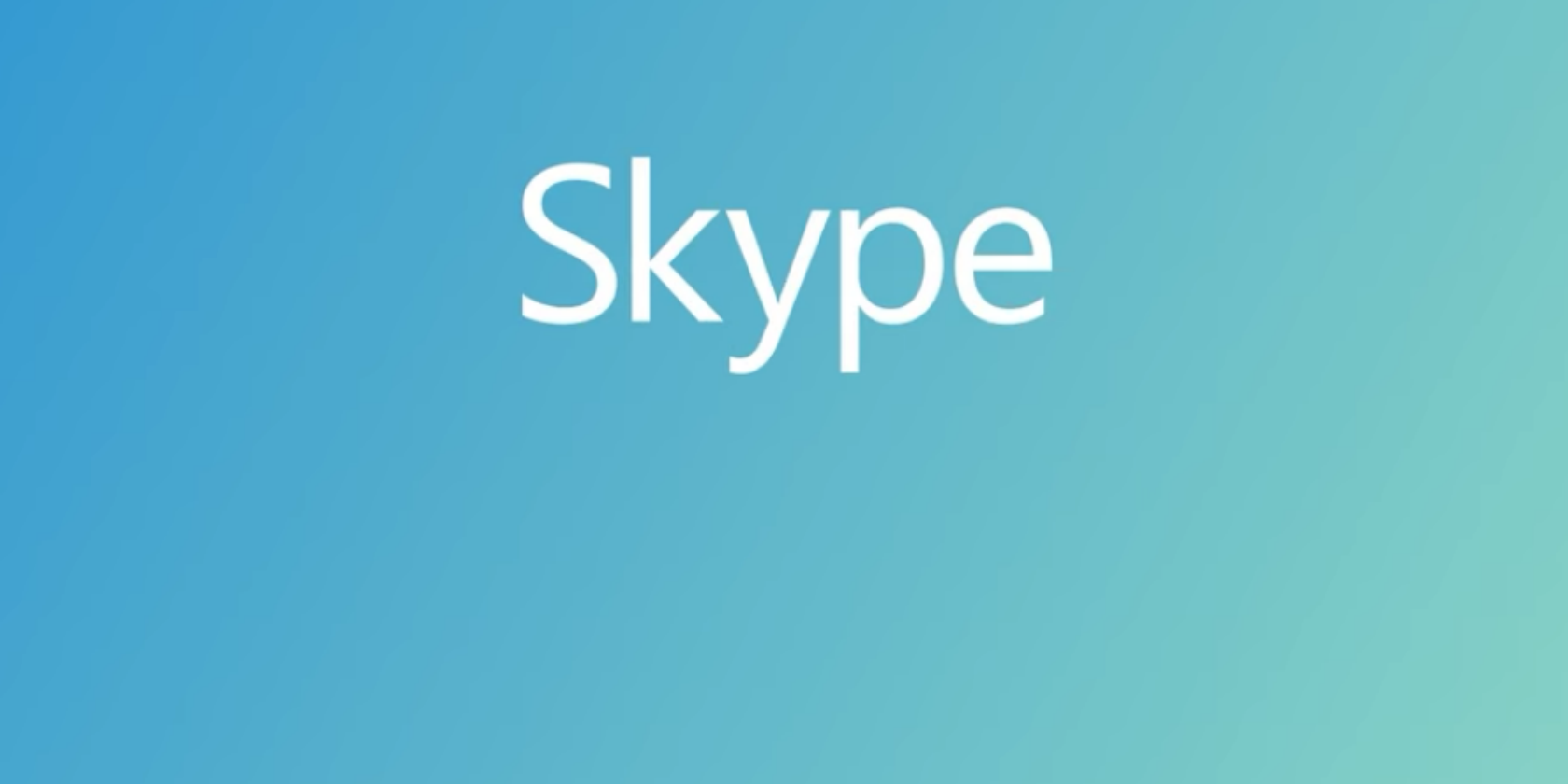
Skype users can now choose to make their voice calls and text chats end-to-end encrypted. This is Microsoft catching up with other messaging apps, including Messenger, Telegram, and WhatsApp, which have offered end-to-end encryption for a while.
End-to-end encryption means that your chats are encrypted from one end to the other, ensuring eavesdroppers can’t intercept your messages or listen into your conversation. It has taken a while for Skype to offer the feature, but it’s better late than never.
Microsoft Launches Private Skype Conversations
Microsoft began testing end-to-end encrypted Skype chats in January, and the feature is now available to all users. You can use Skype’s Private Conversations on Skype for Android, iOS, Windows, Mac, and Linux. But you will need to opt in as it isn’t the default.
Although Skype offers end to end encrypted chats and video calls, don't rely on it to secure your communications. If you want a truly private and secure video call or messaging, use Signal or Wire. There is nothing private when the service is operated by "cooperative" companies
— TNOMM (@Thenewsofmymind) August 21, 2018
There are some restrictions beyond the need to opt in. You can only maintain one Private Conversation at a time, which is rather limiting. And while you can switch that conversation to another device you’ll only see the messages sent on that device.
How to Start a Private Conversation in Skype
To start a Private Conversation in Skype, either go to the Compose menu or the profile of the person you want to contact. Then select “New Private Conversation”. The recipient will receive an invite to launch a Private Conversation, and will need to accept to proceed.
Once the invitation has been accepted, all voice calls, messages, and files will be encrypted from end-to-end, meaning only you and the person you’re chatting with can see them. However, messages aren’t automatically deleted when you end a Private Conversation.
Offering End-to-End Encryption as Default
It has taken Microsoft far too long to add end-to-end encryption, and even now it’s subject to some stifling restrictions. However, we suspect this is just the first step, and Microsoft will add end-to-end encryption to Skype as the default before too long.
In the meantime it might be worth checking out these open source messaging apps more secure than Skype. Or, if you want to learn more about encryption as a whole, read our primer detailing how encryption works and whether it’s really all that safe.
Read the full article: Skype Now Offers End-to-End Encryption
Read Full Article
How to Replay a Snapchat
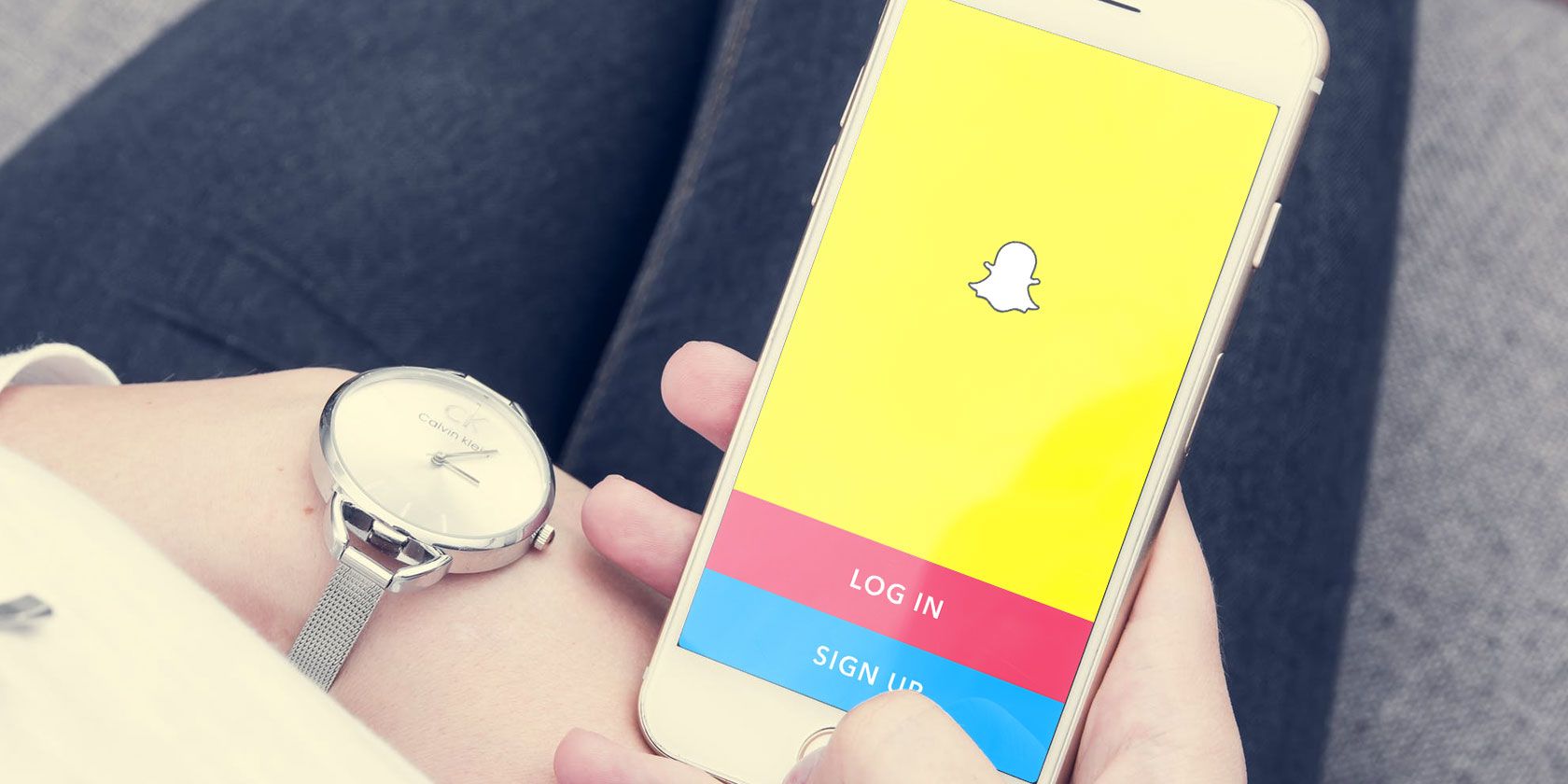
Snapchat made a name for itself thanks to its non-shareable, disappearing images and videos. To this day, it’s still very difficult to grab a screenshot of a Snapchat. There are workarounds, but if Snapchat catches you, your account could be suspended or banned.
However, just because you can’t indefinitely keep the snaps you receive doesn’t mean there aren’t some ways to enjoy the content for a second time. That’s right—it’s possible to replay a Snapchat!
How to Replay a Snapchat
Before we go any further, make sure you’re using Snapchat version 9.29.3.0 or later. If you’re running an older version, the feature will not be available to you.
Also, note that you can no longer buy Snapchat replays. Snapchat has stopped selling them. If you have some unused purchased replays, they are still valid.
Once you’ve confirmed that you’re using the newest version of the app, just follow the simple step-by-step instructions below to replay snaps you have received.
- Make sure you’ve viewed the snap at least once. You won’t see the replay option if you haven’t.
- When you have watched the snap once, stay in the inbox. If you leave the inbox, you will not be able to access the replays.
- Tap and hold on the snap you want to replay.
- The snap icon will fill up.
- Select Tap to view to watch the snap for a second time.
The good news is that Snapchat no longer limits you to one replay per day; you can watch all the snaps you receive twice.
It’s also important to know that if the person sent you a private chat, they will know you have replayed it; it is impossible to replay snaps secretly.
For more Snapchat tips, check out our articles about the meaning of Snapchat’s many emojis and how to make a Snapchat filter.
Read the full article: How to Replay a Snapchat
Read Full Article
How to Use Bing Search for Smarter Hotel Bookings

You probably look to Google when you need to reserve hotels and flights, but Bing isn’t too far behind. Microsoft’s own search engine can aggregate prices from multiple booking sites and help you book the right hotel with its intelligent search.
Here’s how you can make smarter decisions using the intelligent features built into Bing Search.
How to Use Bing Search for Smarter Hotel Bookings
Try these Bing features the next time you are planning a trip and want to grab the best hotel at the lowest price. The features have rolled out in the US.
Use Bing to search for a specific hotel in the US and look at the information cards on the right, or on the Map view, as in the screen below.
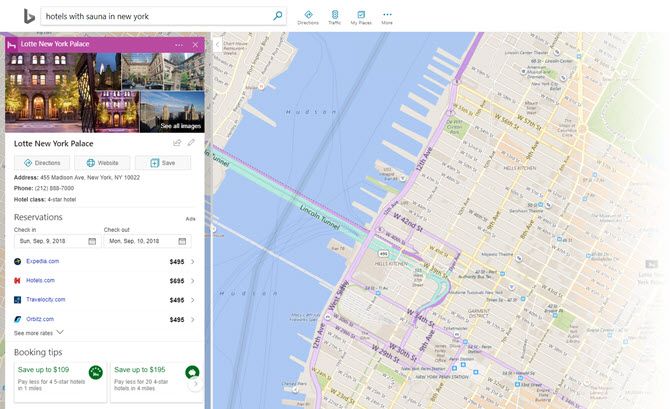
- Basic information. Bing will display information on the hotel like the average room tariff, amenities, and popular check-in times.
- Booking tips for the best decision. Bing will also show booking tips around competing options you may not have considered. For instance, click the Booking Tips will prompt you to check out other hotels that may be rated higher but have similar room tariffs. You can save money with the price discounts mentioned.
- Price trends. Bing displays historical price trends for the date range you’re exploring to help you save money or get your money’s worth.
- Compare hotels side-by-side. Click the map on the search results page. Then, click the Compare button on the left sidebar which allows you to select the checkbox for specific hotels. Click the Compare button again to bring up the detailed breakdown of the amenities in each hotel. This view makes it easier to make a decision.
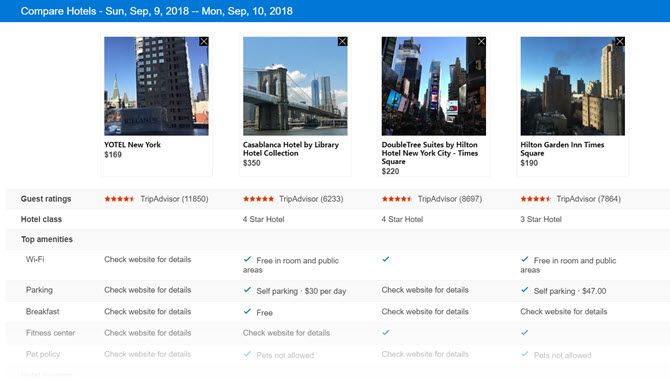
Bing aggregates the information from sites like TripAdvisor, Yelp, Foursquare, and even Facebook to help you get to the right hotel. And maybe save some time and money on every hotel you book on your trips.
Read the full article: How to Use Bing Search for Smarter Hotel Bookings
Read Full Article
Facebook and Twitter remove hundreds of accounts linked to Iranian and Russian political meddling
Facebook has removed hundreds of accounts and pages for what it calls “coordinated inauthentic behavior,” generally networks of ostensibly independent outlets that were in fact controlled centrally by Russia and Iran. Some of these accounts were identified as much as a year ago.
In a post by the company’s head of cybersecurity policy, Nathaniel Gleicher, the company described three major operations that it had monitored and eventually rolled up with the help of security firm FireEye. The latter provided its own initial analysis, with more to come.
Notably, few or none of these were focused on manipulating the 2018 midterm elections here in the states, but rather had a variety of topics and apparent goals. The common theme is certainly attempting to sway political opinion — just not in Ohio.
For instance a page may purport to be an organization trying to raise awareness about violence perpetrated by immigrants, but is in fact operated by a larger shadowy group attempting to steer public opinion on the topic. The networks seem to originate in Iran, and were promoting narratives including “anti-Saudi, anti-Israeli, and pro-Palestinian themes, as well as support for specific U.S. policies favorable to Iran,” as FireEye describes them.
The first network Facebook describes, “Liberty Front Press,” comprised 74 pages, 70 accounts, and 3 groups on Facebook, and 76 accounts on Instagram. Some 155,000 people followed at least one piece of the Facebook network and they had 48,000 Instagram followers. They were generally promoting political views in the Middle East and only recently expanded to the States; they spent $6,000 on ads beginning in January 2015 up until this month.
A related network to this one also engaged in cyberattacks and hacking attempts. Its 12 pages and 66 accounts, plus 9 on Instagram, were posing as news organizations.
A third network had accounts going back to 2011; it was sharing content in the Middle East as well, about local, U.S., and U.K. political issues. With 168 pages and 140 Facebook accounts and 31 Instagram accounts, this was a big one. As you’ll recall, the big takedown of Russia’s IRA accounts only amounted to 135. (The full operation was of course much larger than that.)
This network had 813,000 accounts following it on Facebook and 10,000 on Instagram, and had also spent about $6,000 on ads between 2012 and April of this year. Notably that means that Facebook was taking ad dollars from a network it was investigating for “coordinated inauthentic behavior.” I’ve asked Facebook to explain this — perhaps it was done so as not to tip off the network that it was under investigation.
Interestingly this network also hosted 25 events, meaning it was not just a bunch of people in dark rooms posting under multiple pseudonyms and fake accounts. People attended real-life events for these pages, suggesting the accounts supported real communities despite being sockpuppets for some other organization.
Twitter, almost immediately after Facebook’s post, announced that it had banned 284 of accounts for “coordinated manipulation” originating in Iran.
Working with our industry peers today, we have suspended 284 accounts from Twitter for engaging in coordinated manipulation. Based on our existing analysis, it appears many of these accounts originated from Iran.
— Twitter Safety (@TwitterSafety) August 22, 2018
The Iranian networks were not alleged to be necessarily the product of state-backed operations, but of course the implication is there and not at all unreasonable. But Facebook also announced that it was removing pages and accounts “linked to sources the U.S. government has previously identified as Russian military intelligence services.”
The number and nature of these accounts is not gone into in detail, except to say that their activity was focused more on Syrian and Ukrainian political issues. “To date, we have not found activity by the accounts targeting the U.S.,” the post reads. But at least the origin is relatively clear: Russian state actors.
This should be a warning that it isn’t just the U.S. that is the target of coordinated disinformation campaigns online — wherever one country has something to gain by promoting a certain viewpoint or narrative, you will find propaganda and other efforts underway via whatever platforms are available.
Senator Mark Warner (D-VA) issued a brief I-told-you-so following the news.
“I’ve been saying for months that there’s no way the problem of social media manipulation is limited to a single troll farm in St. Petersburg, and that fact is now beyond a doubt,” he said in a statement. “We also learned today that the Iranians are now following the Kremlin’s playbook from 2016. While I’m encouraged to see Facebook taking steps to rid their platforms of these bad actors, there’s clearly more work to be done.”
He said he plans to bring this up at the Senate Intelligence Committee’s grilling of Facebook, Twitter, and Google leadership on September 5th.
Read Full Article
CardMunch founder returns with HiHello, a new app aiming to replace business cards
A new app called HiHello is taking aim at business cards. While plenty of apps in the past have tried to kill the business card, they never achieved critical mass. Mainly, this is because most required that both parties — the business card holder and recipient — have their app installed. HiHello is different. Instead of forcing everyone to download its app, it simply generates a QR code that can be scanned by anyone with a modern smartphone.
HiHello specifically takes advantage of the fact that today’s smartphones now have QR code readers built in — users no longer need to download a separate QR code scanner app to exchange information over this format.
On iPhone, you can use the native iOS Camera app to scan QR codes. And on Android, Google Lens (a part of Google Assistant) offers similar functionality. (Although this should really be in its camera, too, ahem.)
What this means is that when a HiHello user wants to share their contact information with another person, all they need to do is have the recipient scan the QR code the HiHello app generates. The recipient doesn’t have to download or install anything, and is able to quickly save the contact information right into their phone’s address book.

HiHello also allows you to create different types of cards with different information on them.
For example, you could have one card for your business, one for your side hustle and one for personal connections. This way, you can keep some of your information private, as needed.
You could create a card without your cell number for those contacts you didn’t want to be able to reach you by phone; or you could create a card with your virtual number (e.g. a Skype line or Burner) for dating prospects. You could create a card with your home address, cell and personal email for your family and friends. Or you could make one with your office address, work email, fax and office line for business contacts. And so on.
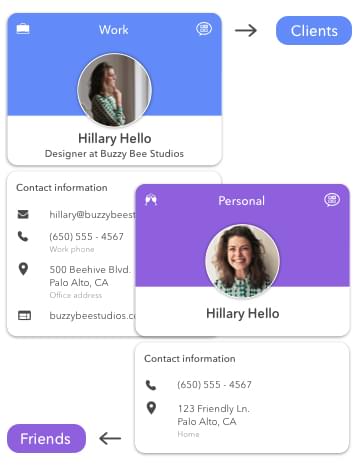 The idea for the app comes from K9 Ventures founder Manu Kumar, who along with co-founder and Caltech and Columbia alum Hari Ravi, and a small team of fewer than half a dozen, has been working on the app following the release of iOS 11, which introduced the QR code reader functionality in the native camera app.
The idea for the app comes from K9 Ventures founder Manu Kumar, who along with co-founder and Caltech and Columbia alum Hari Ravi, and a small team of fewer than half a dozen, has been working on the app following the release of iOS 11, which introduced the QR code reader functionality in the native camera app.
Kumar, in particular, has been trying to solve the problem of business cards for years. In 2009, he co-founded CardMunch to turn business cards into digital contacts. The company was sold to LinkedIn a few years later, but LinkedIn abandoned it and shut it down.
“LinkedIn…failed to recognize the potential for what this could do for them, and in a typical big company fashion proceeded to ruin and eventually kill the product,” Kumar wrote in a blog post about HiHello’s launch. “Yes, I’m still peeved,” he added. (So are we.)
Kumar also noted that another problem with business cards is that people have to carry around different ones to represent their different roles or jobs.
“The information you choose to share with someone is often dependent on the context in which you are meeting that person,” he said.
To address this issue, HiHello allows users to create multiple cards with different information on them, which can be shared via the QR code scan in person, or sent out via text message or email — without exposing the email or phone number tied to your phone.
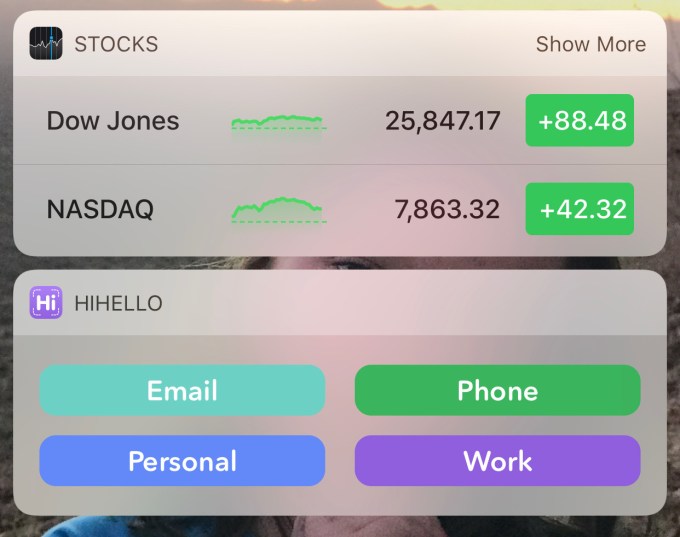
HiHello has also made it easy to find the right card quickly through its iOS and Android widgets that let you choose which card you want to share with just a tap.
The app is straightforward to set up and use. You’re first walked through a form where you enter your basic contact information to get started, and can then proceed to customize the different card types like “work” and “personal,” for example. You also can just choose to share your phone or email. (See above photo).
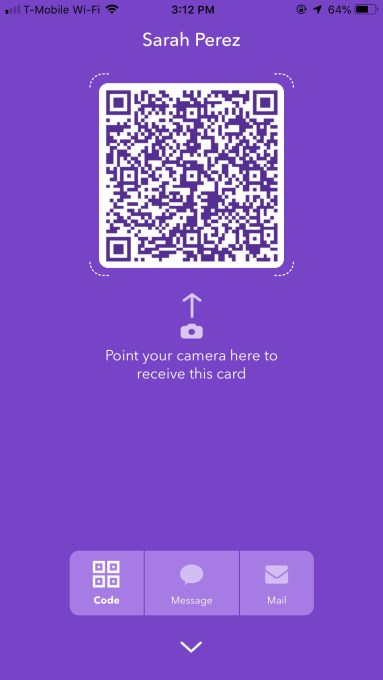
When someone scans the QR code, it launches a website hosted on hihello.com where there’s a link to save the information directly to their phone’s contacts. This link can be sent in other ways right from the QR code screen as well, thanks to buttons at the bottom for “Message” and “Mail.”
The new app is the first step in a bigger vision the company has for contact and relationship management, Kumar notes.
Palo Alto-based HiHello, a team of five, is backed by Kumar’s K9 Ventures. The app is a free download on iOS and Android.
Read Full Article
Google Assistant’s latest feature delivers just the ‘good news’
You’re not the only one feeling run down by the news of the day. The folks at Google apparently believe we could all use a dose of good news, at times, too. The company today announced it’s testing a new Google Assistant feature called “Tell me something good” that will allow users to hear a summary of more uplifting news stories. The stories will focus on people who are “solving problems for our communities and our world,” says Google.
To activate the feature, Assistant users in the U.S. can say, “Hey Google, tell me something good” to kick off the daily briefing of happy stories.
Google offers some examples of what the “good news” may include, like a story about how Georgia State University stopped students from slipping through the cracks; or how backyard beekeepers in East Detroit are bringing back the dwindling bee population; or how Iceland curbed teen drinking.
The stories are selected and summarized by the nonpartisan nonprofit Solutions Journalism Network, an organization that helps train journalists to better cover how people are responding to problems and how those actions can have positive results.
The stories themselves, meanwhile, will be chosen from a wide range of media outlets.
The feature arrives at a time when many people are feeling overwhelmed by the news, much of which is negative and troubling.
Some psychologists believe this sort of exposure may have long-lasting effects on mental health, contributing to stress, anxiety, depression, and even PTSD, in some cases. The impact may be greater if the news outlets you’re exposed to emphasize the suffering and emotional components of the stories they present, according to psychologist Dr. Graham Davey, who spoke to The Huffington Post about the topic back in 2015.
In addition, a more recent survey from the American Psychological Association found that more than half of Americans now say that the news causes them stress, and many report feeling anxiety, fatigue or experiencing sleep loss as a result. And new data from Blue Cross Blue Shield states that more than 9 million people in the U.S. are now suffering from major depression – up 33% from 2013 through 2016.
Of course, many people continue to keep up because they feel it’s their responsibility to stay informed.
Unfortunately, what’s shifted between the era of the daily paper and the nightly TV news, is the way people consume news. Stories often include visual or shocking elements, and include videos, photos, and audio clips captured by bystanders. We’re also continually checking our phones throughout the day, as well, instead of reading or watching news at designated times.
Being addicted to social media isn’t helping either – continually scrolling through our feeds is something that’s already linked to feelings of social isolation, as well as prolonged feelings of hopelessness or sadness, studies have shown.
A dose of good news from Google Assistant won’t solve these problems, as not everyone is aware of the cause of their stress and anxiety, nor will they seek out solutions to make themselves feel better. Plus, listening to a few good stories here and there won’t cancel out the larger majority of “bad” news stories that we more regularly consume.
Google acknowledges this feature won’t be some sort of “magic bullet,” it says.
“But it’s an experiment worth trying because it’s good info about good work that may bring some good to your day,” the company says.
The Google Assistant feature works on any Assistant-enabled devices including mobile phones, smart displays or Google Home devices.
Read Full Article
Study ties Facebook engagement to attacks on refugees
A study of circumstances and demographics attendant on attacks against refugees and immigrants in Germany has shown that Facebook use appears to be deeply linked with the frequency of violent acts. Far from being mere trolling or isolated expressions of controversial political opinions, spikes in anti-refugee posts were predictive of violent crimes against those groups.
The study was conducted by Karsten Müller and Carlo Schwarz of the University of Warwick. Their theory was that if country-wide waves of “right wing anti-refugee sentiment” result in subsequent waves of actual crime; these waves would travel the way any others do, via TV, word of mouth, radio, and of course social media.
Now, if the anti-refugee rhetoric spreads via social media, then we can expect more crimes to occur in areas where there is more social media use, right? And specifically, areas where there is more activity among anti-refugee groups would see the most.
To test this theory, Müller and Schwarz used activity on a pair of major Facebook pages in Germany to measure social media use in general and specific to right-wing groups. For right-wing activity they looked at page of the “Alternative for Germany” party, the most popular anti-immigration political faction in the country and one that does not attempt to control the conduct on its threads. As a measure of overall Facebook use, they used Nutella’s popular public German page.
With hundreds of thousands of posts and comments broken down by area, the researchers were able to identify overall patterns of social media use, and then isolate anti-refugee sentiment within that. Their findings are unambiguous:
Using these measures, we find that anti-refugee hate crimes increase disproportionally in areas with higher Facebook usage during periods of high anti-refugee sentiment online. This effect is especially pronounced for violent incidents against refugees, such as arson and assault. Taken at face value, this suggests a role for social media in the transmission of Germany-wide anti-refugee sentiment.
A quick estimate on their part suggests that the social media activity may have increased attacks by 13 percent or so — not a number to be quoted as definitive, but rather an indicator that we are not quibbling over half a percent here and there but meaningful numbers.
But the researchers are also careful both to carefully define the scope of those findings:
We do not claim that social media itself causes crimes against refugees out of thin air. In fact, hate crimes are likely to have many fundamental drivers; local differences in xenophobic ideology or a higher salience of immigrants are only two obvious examples. Rather, our argument is that social media can act as a propagating mechanism for the flare-up of hateful sentiments. Taken together, the evidence we present suggests that quasi-random shifts in the local population’s exposure to such sentiments on social media can magnify their effect on refugee attacks.
…and to account for the many confounding variables that may invisibly affect the data, of which below.
Correlation vs causation
No doubt many readers will be skeptical of any study like this one; after all, these are very complex issues with many moving parts, and correlations may appear between things regardless of whether those things directly cause or effect one another. Fortunately the researchers foresaw this objection and were circumspect in their delineation of the link between social media use and attacks.
There are a handful of prominent possible alternative explanations, which the paper deals with in various ways.
First is the possibility that attacks are just more likely in areas where there is heavier social media use. This was my first thought: where are conflicts likely to occur? In places with dense and diverse populations, which seem likely to also have more internet and social media use.
This is dispatched in several ways. In the first place, the study looks at changes in violence levels within an area, not across the whole of Germany. In other words, the pattern of anti-immigrant posts preceding anti-immigrant violence is seen whether it takes place in a smaller town with low levels of social media engagement, or in larger cities where Facebook use is much more frequent.
Next, the Nutella control group provides a measure of social media activity independent of political issues — so patterns of use for a broad swath of users associated with seasons, weekly rhythms, holidays and so on can be identified down to the level of the county. When a population deviates from that pattern, you can be reasonably sure that something about that population is driving that deviation.
Something they couldn’t exactly control but is nonetheless useful is seeing how various internet and Facebook outages affect the patterns. It turns out that internet disruptions completely eliminate the increases in violence normally seen during a country-wide wave of anti-immigrant sentiment. Furthermore, they write, “the effect of refugee posts on hate crimes essentially vanishes in weeks of major Facebook outages.”
Spikes in activity expressing negative feelings towards other frequently targeted groups, for instance Jews, were not associated with increases in refugee-related violence, so it isn’t just that people lash out when they are feeling especially hateful.
Lastly, the researchers showed that other coverage of refugee-related issues, like that by major news outlets, drives local engagement in the form of protests, but does not seem to predict violent acts.
As the researchers say, Facebook isn’t just plain causing violence to happen. The places where it happens are often historically right-wing places that have had higher incidence of violence and hate crimes in the past. But it seems inescapable that Facebook is nevertheless an important way that refugee-related hatred and vitriol in particular is spread, as evidenced by the lack of increases in violence when the social network is unavailable.
The connection seems clear: hateful content spreads via Facebook and where it is engaged with the most, there you find the most violence. On its face this doesn’t seem like something Facebook can moderate away — it’s a natural consequence of how the fundamental social media ecosystem pioneered by Facebook works. Having it repeatedly and systematically connected with increases in violence isn’t a good look.
Read Full Article
How to Chop Down a 20,000 Email Inbox to Zero in 30 Minutes

Between promotions, newsletters, notifications, and everything else that comes flying into your inbox every day, it’s very easy to accumulate too many emails. If you don’t have time to deal with it, you could find yourself sitting on an inbox with upwards of 20 to 30 thousand messages.
Somewhere in there, you’ve got important messages you don’t want to lose. But how do you empty out the clutter without tossing out the baby with the bathwater?
If you follow the process outlined in this article, you can get yourself down to inbox zero in at least 30 minutes. At the most, one hour. Want to give it a try? Open up your bloated inbox, and follow along.
The Bloated Gmail Inbox
Introducing, the inbox of a very busy person.
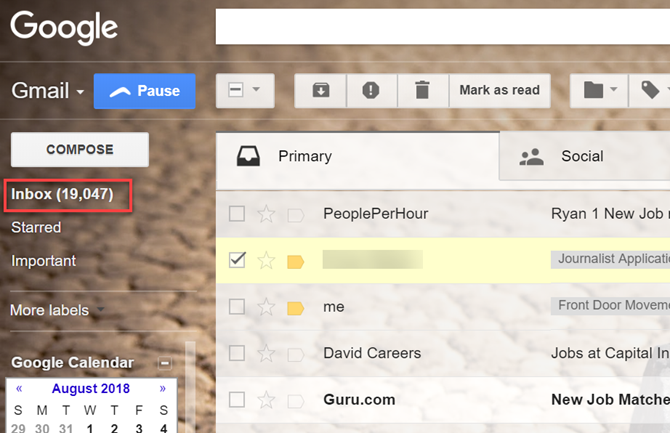
That’s right. Almost 20,000 unread email messages. Those are only the unread ones. The total size of my email account before starting this process was pushing 35,000 messages.
So, the first thing to do is chop off the low hanging fruit.
Toss Out the Trash
It should go without saying that you need to take out the trash often, not only at home but in your Gmail inbox as well.
Click on your Trash in the left navigation bar, click the “select all” box at the top of the message list, and then click on the “All conversations” link listed before the first email.
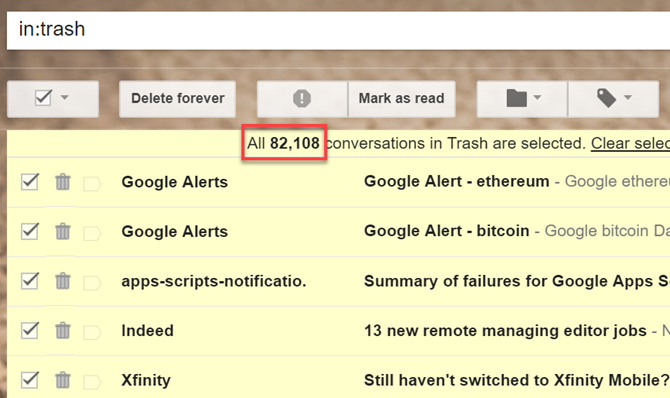
Then click on Delete Forever.
Next, go after Gmail spam. In the navigation field, click on the Spam link, and then click on “Delete all spam messages now”.
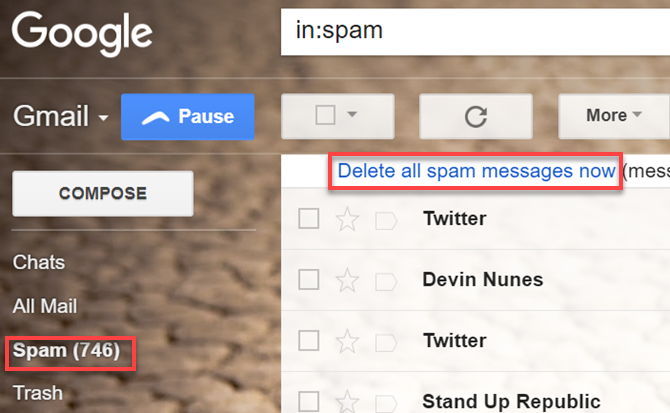
Feels good, right? We haven’t really put a dent in the inbox yet, but it’s a great feeling to start cleaning your inbox after you’ve taken out the trash.
Now for the next level of low hanging fruit.
Social and Promotions
If you’re using Google’s default style Gmail inbox, then you’ll see Social and Promotion tabs at the top of your inbox.
Click on each of these and scroll down through the list looking for large volumes of duplicates.

These are the culprits that are filling up your inbox every day.
When you find them, open the email and find the Unsubscribe link near the top or bottom of the email.

Only go through the first few pages of Social and Promotion posts looking for large groups of duplicates. Just wiping out your most recent newsletters will drastically reduce the amount of email filling your inbox every day.
Don’t spend too much time doing this, because there are bigger fish to fry right now. After you’re done with this article, you’ll want to go through Sandy’s article on mastering Gmail inbox anxiety to prevent yourself from getting into this mess all over again.
Once you’ve unsubscribed from the most common emails, click on the Select All icon at the top again, and click on the “Select all conversations” link at the top.
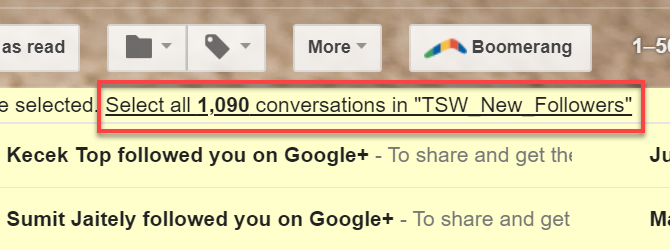
Click the trash icon to delete them all.
Repeat the same process on the Promotions tab. By the time you’re done deleting all of these, you’ve likely already chopped your inbox down by a few thousand.
And you’re only getting warmed up.
Backup and Delete Labeled Emails
Years ago, I used to be part of a team that conducted online investigations. Over the time I was there I accumulated a few thousand emails—all of them applied with a special Gmail label of the incoming, linked email address.
The address closed in 2015 but I never bothered deleting all of those emails.
You’ve likely created all sorts of labels years ago. Maybe you even automated the process with filters for incoming emails. All of those emails are just sitting there wasting space.
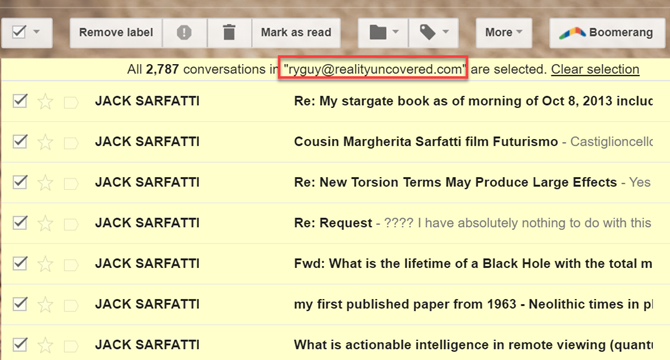
You can’t just delete labeled emails in bulk, because you labeled them for a reason. Maybe they contain years of research, or they’re a historical archive of some work you did that you just don’t want to lose.
Back Up Important Labeled Emails
Luckily, it’s very easy to back up all those emails in bulk using Google’s account export feature.
Google offers a Download Your Data page for every service in your Google account.
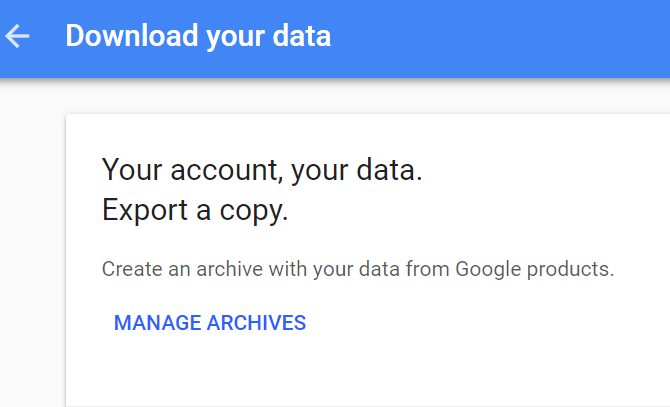
Click on Manage Archives link, and then click on Create New Archive.
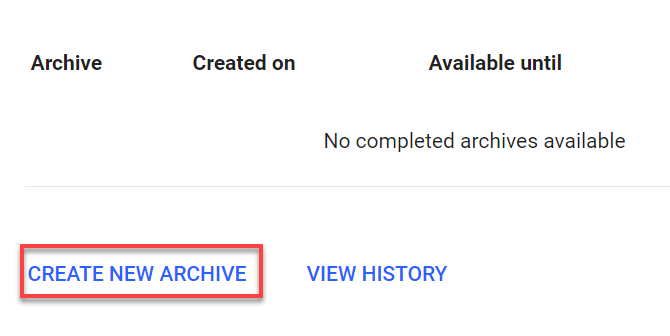
Scroll down to your list of accounts and click Select None to deselect all accounts.
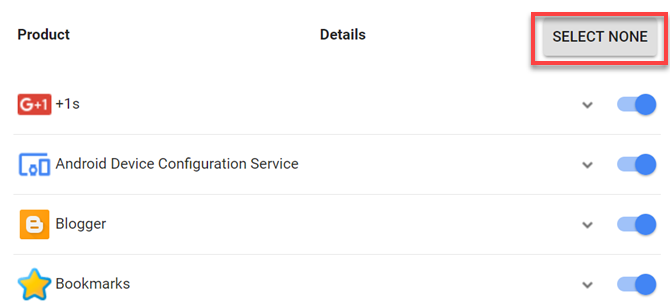
Then scroll down to your Gmail account, and click the switch to enable that service only.
Click the dropdown arrow, and click on Select labels.
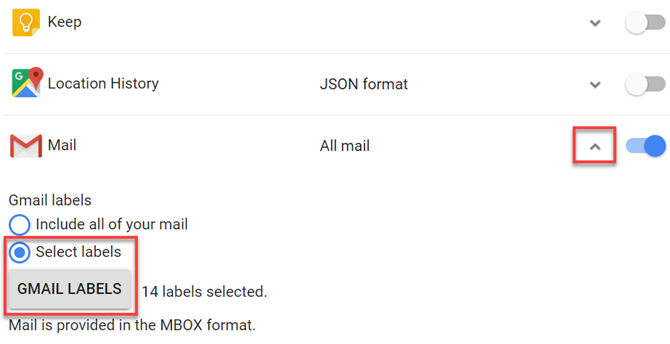
Go down the list of labels you’ve created in your Gmail account, and select all of the ones you want to take a full backup of.
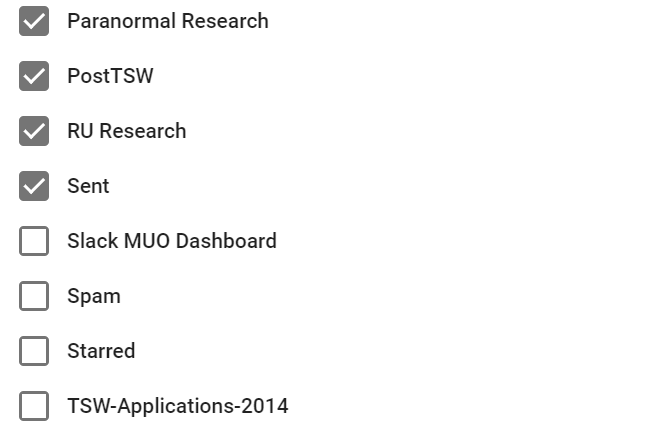
Under the list, you can select the compressed file format and the max archive size.
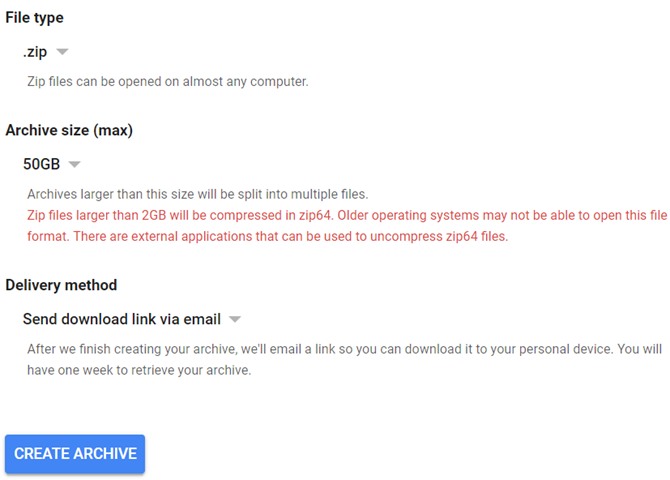
Finally, click the Create Archive button.
Google will email you that it’s started taking your archive. It could take a few hours or even a day, but eventually, you’ll receive a follow-up email when the archive is ready to download. The download link will be right in the email message.
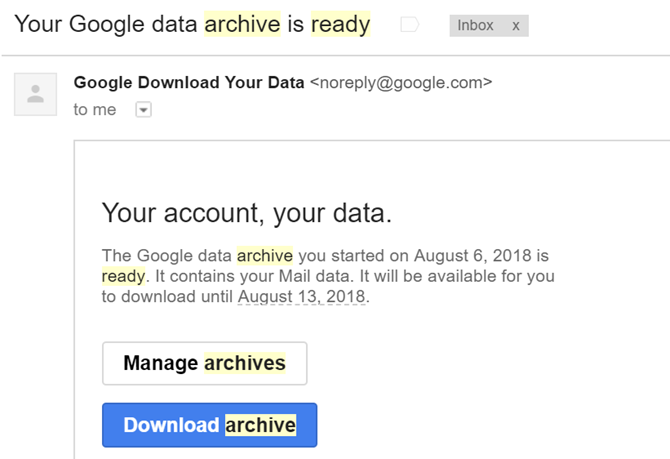
Once you’ve downloaded and saved your email archive someplace safe, you’re ready to start wiping out labeled emails.
Delete Labeled Emails and Labels
Back in your Gmail inbox, click on each label so the emails display, and select All from the select list.
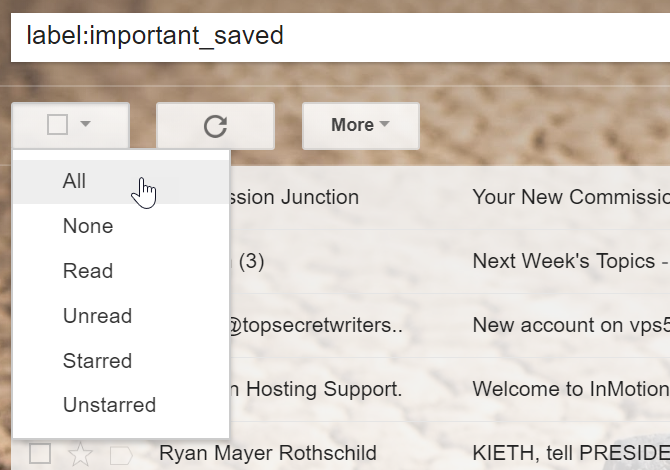
Remember to select all conversations like you did before.
Click the trash icon to delete all of those emails.
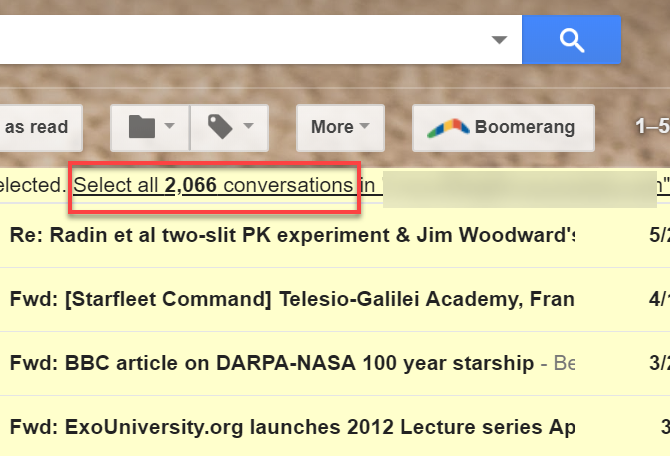
If you’re lucky, you’ll come across labels with thousands of emails you can clean out of your inbox now that you have a backup.
Once you’ve cleaned out all of the emails, don’t forget to delete all those old labels. Just click the dropdown on the right side of the label name and choose Remove label from the list.
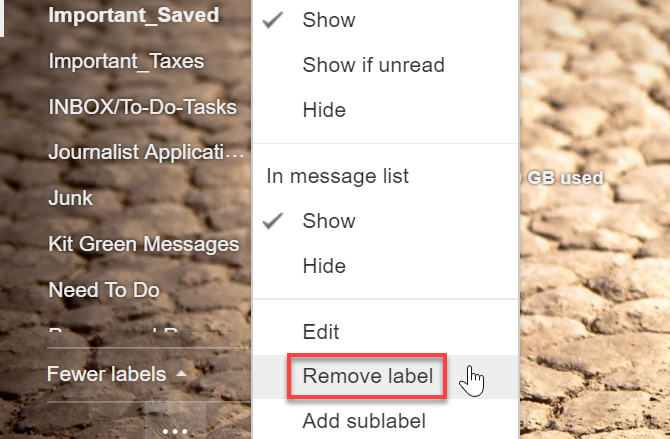
At this point, you should have already chopped down the size of your inbox significantly. But let’s not hold back. We’ve got a few more tricks up our sleeves.
Delete Old Emails
If you have tens of thousands of emails, the odds are pretty good that even the emails that used to be important four or five years ago aren’t very important anymore.
Now’s the time to really dig deep and clean house. Let’s get rid of those very old emails.
To do this, just type “older_than:2y” in the Gmail search field. You can set any time limit you want by changing 2 to whatever number of years of email you’d like to keep.
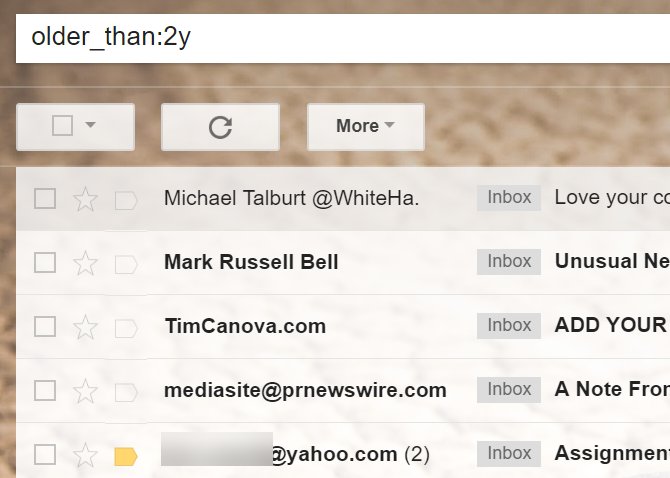
Just remember that whatever volume of emails you “keep”, you’re going to have to sort through at the end to pull out the truly important ones. So make this timeframe as small as you’re comfortable with.
Select All emails, and select all conversations, then click the Trash icon just like you’ve been doing all along.
After that, your email inbox of tens of thousands should be getting down into at last the single thousands by this point.
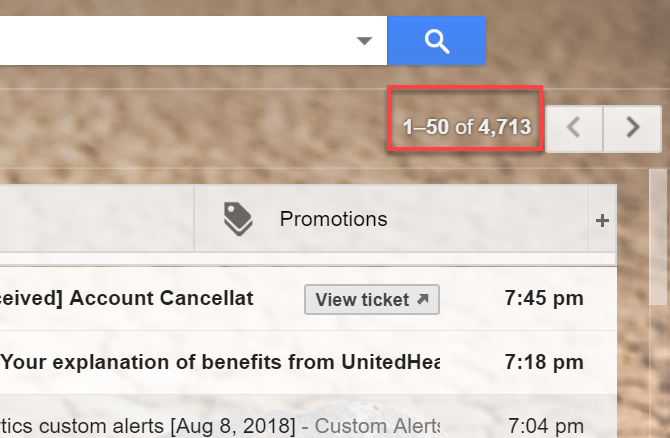
At this point, it’s time to take a slightly more selective approach to clean up the remaining mess.
Clean, Sort, and Organize
First, consider that any email you haven’t actually opened beyond a couple of weeks ago, you’re probably never going to open.
You can quickly clean those up by searching for all unread emails older than ten days.
In the search field, just type “is:unread older_than:10d”.
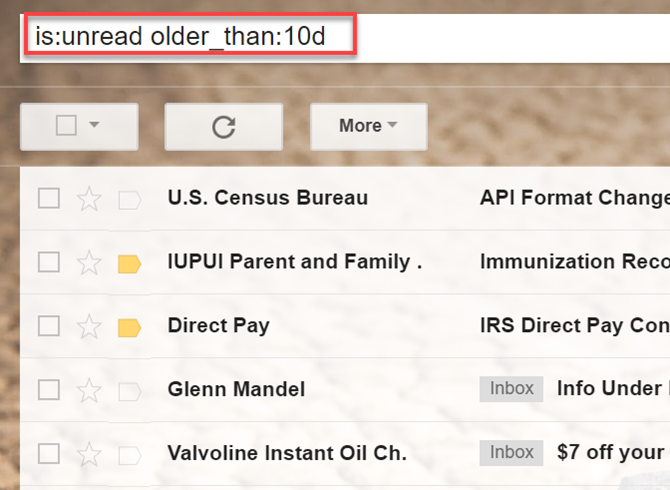
Select and delete all of those listed emails.
Another approach to trim down the remaining list of emails even further is to search for typical spam or promotional subject lines. You can do this by typing searches like “subject: deal”, “subject: giveaway” or “subject: last chance”.
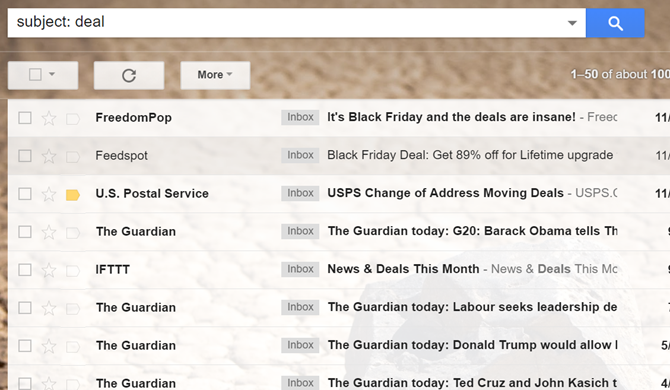
Every search should turn up well over 100 emails at a time. Just keep wiping them out.
Finish Off Your Inbox
At this point, your mountain of tens of thousands of emails should be pared down to a much more manageable size. You’ve now concentrated your inbox to mostly email messages that are important to you and that you may want to keep.
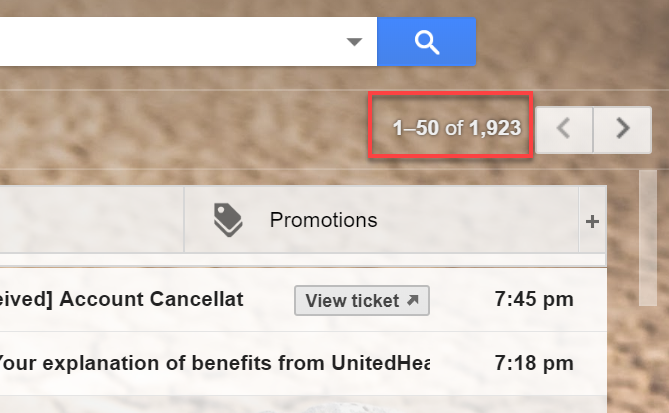
Next, start scrolling through the remaining emails. When you spot important emails you want to keep, just drag them over to the labels you’ve created for them (or create new labels if they don’t exist yet).
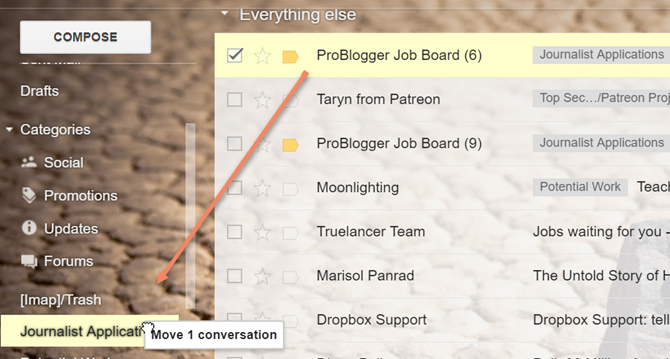
This sounds like a chore, but visually scanning a page of emails at a time should only turn up a few you actually want to keep. Then you can select all emails on that page and delete them all. This will wipe out 50 or so emails at a time.
Remember, whenever you notice a repeat sender turning up, open the email and click the dropdown arrow next to the reply button. From this list click “Filter messages like this”.
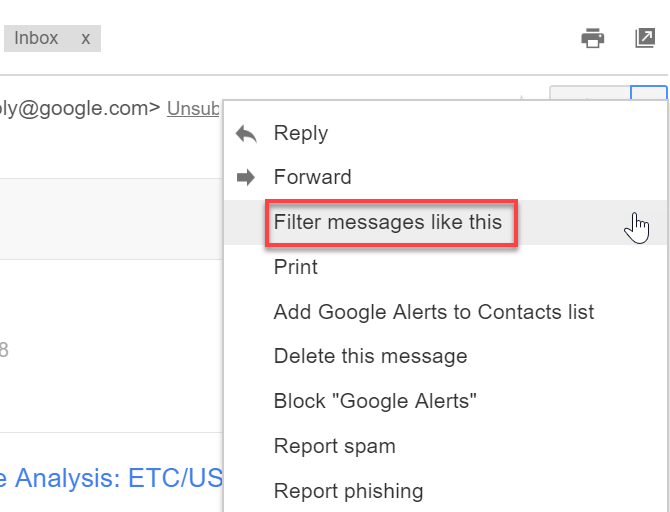
Then select all and delete the list of matching emails that show up.
By labeling, filtering, and deleting big blocks of emails, you’ll have that list of just over 1,000 emails down to that miraculous inbox zero in no time.
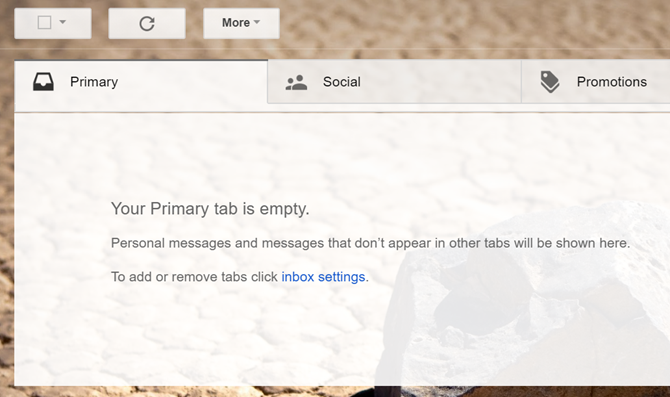
It’s a tremendous feeling seeing that “empty” note in the inbox, especially when you’ve gone years without seeing it!
Don’t Let the Beast Grow
Now that you’ve taken the time to finally get that giant beast of an inbox under control again, it’s important to keep it from growing too big again. The best way to do that is to study all of the features Gmail has available to keep things organized and streamlined.
You can learn about those features in our Power User Guide to Gmail, and never face having to go through this process again.
Image Credit: Nomadsoul1/Depositphotos
Read the full article: How to Chop Down a 20,000 Email Inbox to Zero in 30 Minutes
Read Full Article
